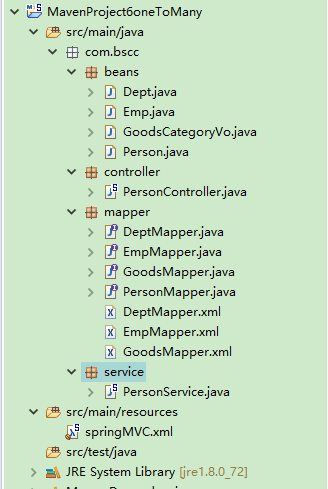溫馨提示×
您好,登錄后才能下訂單哦!
點擊 登錄注冊 即表示同意《億速云用戶服務條款》
您好,登錄后才能下訂單哦!
這篇文章給大家介紹使用mybatis遞歸怎么實現一對多,內容非常詳細,感興趣的小伙伴們可以參考借鑒,希望對大家能有所幫助。
CREATE TABLE `goods_category` ( `goodscateid` int(11) NOT NULL AUTO_INCREMENT, `name` varchar(255) DEFAULT NULL, `parentid` int(11) DEFAULT NULL, `description` varchar(255) DEFAULT NULL, `displayorder` int(11) DEFAULT NULL, `commissionrate` double DEFAULT NULL, `enabled` int(11) DEFAULT NULL, PRIMARY KEY (`goodscateid`) ) ENGINE=InnoDB AUTO_INCREMENT=11 DEFAULT CHARSET=utf8; /*Data for the table `goods_category` */ insert into `goods_category`(`goodscateid`,`name`,`parentid`,`description`,`displayorder`,`commissionrate`,`enabled`) values (1,'java',0,'111',NULL,NULL,NULL),(2,'spring',1,'222',NULL,NULL,NULL),(3,'springmvc',1,'333',NULL,NULL,NULL),(4,'struts',1,'444',NULL,NULL,NULL),(5,'jdbc',0,'555',NULL,NULL,NULL),(6,'hibernate',5,'666',NULL,NULL,NULL),(7,'mybatis',5,'777',NULL,NULL,NULL),(8,'jdbctemplate',5,'888',NULL,NULL,NULL),(9,'beanfactory',3,'999',NULL,NULL,NULL),(10,'factorybean',3,'000',NULL,NULL,NULL);
實體類
@JsonIgnoreProperties({"displayorder","commissionrate","enabled"})
public class GoodsCategoryVo {
private Integer goodscateid;
private String name;
private Integer parentid;
private String description;
private Integer displayorder;
private Double commissionrate;
private Integer enabled;
private List<GoodsCategoryVo> catelist;
get 。。。 set。。。 tostring。。。dao層
public interface GoodsMapper {
List<GoodsCategoryVo> getCategory(Integer pid);
}mapper.xml
<resultMap id="getSelf" type="com.bscc.beans.GoodsCategoryVo">
<id column="goodscateid" property="goodscateid"></id>
<result column="name" property="name"></result>
<collection property="catelist" select="getCategory"
column="goodscateid"></collection>
<!--查到的cid作為下次的pid -->
</resultMap>
<select id="getCategory" resultMap="getSelf">
select * from goods_category where parentid=#{pid}
ORDER BY displayorder,goodscateid
</select>之后直接訪問對應的方法,即可查詢出來
@RequestMapping("/getGoodsList")
@ResponseBody
public List<GoodsCategoryVo> getGoodsList(){
// pid指定為0
List<GoodsCategoryVo> list = goodsMapper.getCategory(0);
return list;
}結果,可以使用json在線工具 ,也可以使用這個工具
[
{
"goodscateid": 1,
"name": "java",
"parentid": 0,
"description": "111",
"catelist": [
{
"goodscateid": 2,
"name": "spring",
"parentid": 1,
"description": "222",
"catelist": []
},
{
"goodscateid": 3,
"name": "springmvc",
"parentid": 1,
"description": "333",
"catelist": [
{
"goodscateid": 9,
"name": "beanfactory",
"parentid": 3,
"description": "999",
"catelist": []
},
{
"goodscateid": 10,
"name": "factorybean",
"parentid": 3,
"description": "000",
"catelist": []
}
]
},
{
"goodscateid": 4,
"name": "struts",
"parentid": 1,
"description": "444",
"catelist": []
}
]
},
{
"goodscateid": 5,
"name": "jdbc",
"parentid": 0,
"description": "555",
"catelist": [
{
"goodscateid": 6,
"name": "hibernate",
"parentid": 5,
"description": "666",
"catelist": []
},
{
"goodscateid": 7,
"name": "mybatis",
"parentid": 5,
"description": "777",
"catelist": []
},
{
"goodscateid": 8,
"name": "jdbctemplate",
"parentid": 5,
"description": "888",
"catelist": []
}
]
}
]mybatis遞歸就是這么的簡單。
說下mybatis一對多實現
對應的bean
public class Dept {
private Integer id;
private String deptName;
private String locAdd;
private List<Emp> emps@JsonIgnoreProperties("dept")
public class Emp {
private Integer id;
private String name;
private Dept dept;dao層
public interface DeptMapper {
public Dept getDeptById(Integer id);
}public interface EmpMapper {
public Emp getEmpByDeptId(Integer deptId);
}mapper.xml文件
<mapper namespace="com.bscc.mapper.DeptMapper">
<resultMap id="DeptResultMap" type="com.bscc.beans.Dept">
<id property="id" column="id"/>
<result property="deptName" column="deptName"/>
<result property="locAdd" column="locAdd"/>
<!-- private List<Emp> emps; column="id"寫被集合對象主鍵,select按照外鍵鍵查詢,通過deptid查出emp給dept-->
<collection property="emps" column="id" ofType="Emp" select="com.bscc.mapper.EmpMapper.getEmpByDeptId"/>
</resultMap>
<select id="getDeptById" parameterType="Integer" resultMap="DeptResultMap">
select * from tbl_dept where id=#{id}
</select>
</mapper><mapper namespace="com.bscc.mapper.EmpMapper">
<resultMap id="EmpResultMap" type="com.bscc.beans.Emp">
<id property="id" column="id"/>
<result property="name" column="name"/>
</resultMap>
<select id="getEmpByDeptId" parameterType="Integer" resultMap="EmpResultMap">
select * from tbl_emp where deptId=#{deptId}
</select>
</mapper>對應的controller方法
@RequestMapping("/getDeptById")
@ResponseBody
public Dept getDeptById() {
Dept deptById = deptMapper.getDeptById(1);
return deptById;
}無非就是比簡單查詢復雜一些罷了。
代碼目錄

關于使用mybatis遞歸怎么實現一對多就分享到這里了,希望以上內容可以對大家有一定的幫助,可以學到更多知識。如果覺得文章不錯,可以把它分享出去讓更多的人看到。
免責聲明:本站發布的內容(圖片、視頻和文字)以原創、轉載和分享為主,文章觀點不代表本網站立場,如果涉及侵權請聯系站長郵箱:is@yisu.com進行舉報,并提供相關證據,一經查實,將立刻刪除涉嫌侵權內容。